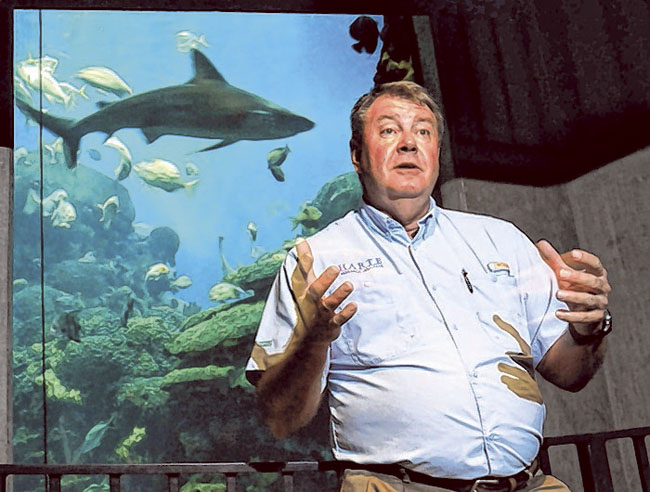As Gulf recovers from spill, scientists assess damage
Wednesday, April 20, 2011
 Larry McKinney, director of the Harte Research Institute in Corpus Christi, talks about the effects of the British Petroleum oil spill last year in the Gulf of Mexico as a sandbar shark passing inside the Secret Reef exhibit Tuesday at the Tennessee Aquarium.
Staff Photo by Tim Barber/Chattanooga Times Free Press
Larry McKinney, director of the Harte Research Institute in Corpus Christi, talks about the effects of the British Petroleum oil spill last year in the Gulf of Mexico as a sandbar shark passing inside the Secret Reef exhibit Tuesday at the Tennessee Aquarium.
Staff Photo by Tim Barber/Chattanooga Times Free PressOne year after the Gulf of Mexico oil spill, marine scientist Larry McKinney says researchers are still in a "diagnostic phase," trying to fully understand the spill's consequences.
On the surface, he said, the Gulf is in relatively good shape.
"As big as the spill was, the Gulf is bigger," he said.
But the Gulf still hasn't completely recovered, and it may take years to know the full damage, he said.
"We believe it may take another one to two years for beaches and some fisheries to recover. Wetlands may take up to five more years to recover, along with some bird species," said McKinney, who is in Chattanooga for several days as a guest and lecturer for the Tennessee Aquarium. "And some impacts may not even be uncovered for a couple of years."
McKinney is the executive director of the Harte Research Institute for Gulf of Mexico Studies. His organization, part of Texas A&M University in Corpus Christi, focuses on the Gulf's overall environmental health and tries to help people understand the scope of the Gulf's importance.
Today is the one-year anniversary of BP's Deepwater Horizon spill following an explosion on the oil rig that killed 11 workers and opened an underwater gusher estimated to have released more than 172 million gallons of crude oil.
The gusher continued for three months - spewing 50,000 to 60,000 barrels a day.
McKinney said he and other researchers think about 30 percent of the spilled oil remains at sea, lying on the deep Gulf floor.
"The greatest impacts will be on that bottom and in the water column up from there and all the animals there," he said.
Most scientists agree the effects "were not as severe as many had predicted," Christopher D'Elia, dean at the School of the Coast and Environment at Louisiana State University, told The Associated Press. "People had said this was an ecological Armageddon, and that did not come to pass."
Still, biologists are concerned about the spill's long-term damage on marine life.
"There are these cascading effects," D'Elia said. "It could be accumulation of toxins in the food chain, or changes in the food web. Some species might dominate."
BP's Chairman Carl-Henric Svanberg told a Swedish newspaper Tuesday that BP is about halfway through the process of handling the demands from residents in the Gulf, where oystermen were made redundant, hotels left empty and fears are growing that the underwater ecosystem was badly damaged.
"It is a burdensome road to regain the trust of the American people. The U.S. is one of the countries reacting the loudest when something happens, but maybe also the fastest country to note when someone performs well," Svanberg said.
Researchers already are worried about higher-than-normal numbers of aborted dolphins being found, as well as sperm whale deaths and other signs of long-term problems.
McKinney said they don't yet know if those deaths are from natural causes, oil ingestion or from chemicals, including some used to contain the spill.
Research before the spill had shown the Gulf already was under assault from the fertilizers carried by the Mississippi River from 40 percent of the nation's lawns, golf courses and farms.
Better regulation of the oil drilling can help with future spills, he said, but changing the habits of most farmers and property owners must start at home.
"If you can take care of Tennessee, it will help the Gulf," he said.
The Associated Press contributed to this story.
